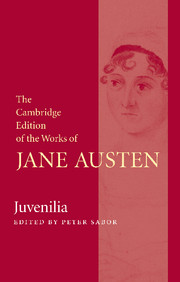Book contents
- Frontmatter
- Contents
- General editor’s preface
- Acknowledgements
- Chronology
- Introduction
- Note on the text
- Volume the First
- Volume the Second
- Volume the Third
- Corrections and emendations
- Appendix A The History of England: facsimile
- Appendix B Marginalia in Oliver Goldsmith’s The History of England, from the Earliest Times to the Death of George II
- Appendix C Marginalia in Vicesimus Knox’s Elegant Extracts . . . in Prose
- Appendix D Sophia Sentiment’s letter in The Loiterer, 28 March 1789
- Appendix E Continuations of ‘Evelyn’ and ‘Catharine’ by James Edward Austen and Anna Lefroy
- Abbreviations
- Explanatory Notes
Appendix D - Sophia Sentiment’s letter in The Loiterer, 28 March 1789
Published online by Cambridge University Press: 18 December 2020
- Frontmatter
- Contents
- General editor’s preface
- Acknowledgements
- Chronology
- Introduction
- Note on the text
- Volume the First
- Volume the Second
- Volume the Third
- Corrections and emendations
- Appendix A The History of England: facsimile
- Appendix B Marginalia in Oliver Goldsmith’s The History of England, from the Earliest Times to the Death of George II
- Appendix C Marginalia in Vicesimus Knox’s Elegant Extracts . . . in Prose
- Appendix D Sophia Sentiment’s letter in The Loiterer, 28 March 1789
- Appendix E Continuations of ‘Evelyn’ and ‘Catharine’ by James Edward Austen and Anna Lefroy
- Abbreviations
- Explanatory Notes
Summary
The Loiterer, a weekly periodical, was launched on Saturday, 31 January 1789 by Jane Austen's eldest brother James, then a Fellow of St John's College, Oxford. Its aim, according to James's first editorial, was to supply ‘a regular succession of moral lectures, critical remarks, and elegant humour’ (no. 1, p. 3). It continued to appear every Saturday for almost fourteen months, until the sixtieth and final number was published on 20 March 1790. A few weeks later, the weekly issues were collected into two substantial volumes, giving The Loiterer a wider circulation than its original, primarily Oxford readership. The contributions are unsigned, but in the final number James Austen provided a key to their authorship. Of the sixty essays, twenty-nine are by James himself; nine are by his brother Henry, then a Scholar at St John’s; two are by the Revd Benjamin Portal, with a third by Portal and Henry in collaboration; and the others are by various Oxonians, most of them unidentified.
Among James's contributions to The Loiterer is issue number nine, published on 28 March 1789, which begins by introducing a letter ‘brought us the last week … and as it is the first favour of the kind we have ever received from the fair sex (I mean in our capacity of authors) we take the earliest opportunity of laying it before our readers’ (pp. 3–4). The letter itself follows, above the pseudonym ‘Sophia Sentiment’, complaining that The Loiterer had hitherto neglected its female readers; unless this is rectified, Sophia will ‘soon drop your acquaintance’. James's reply is a mock-solemn defence of The Loiterer against the letter-writer's various charges. It is possible that James Austen wrote the letter as well as the response. His key to authorship says nothing about ‘Sophia Sentiment’, and the letter is nowhere mentioned in his surviving papers or in any Austen family documents. It is, however, more probable that Sophia was a female writer known to James, and his sister Jane Austen, then aged thirteen, is much the most likely candidate.
- Type
- Chapter
- Information
- Juvenilia , pp. 356 - 362Publisher: Cambridge University PressPrint publication year: 2006

